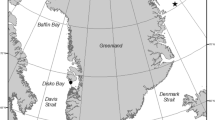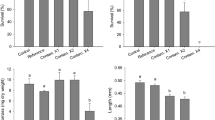Abstract
Extraction of Canada’s oil sands has created 1 billion m3 of tailings, which are stored in on-site tailings ponds. Due to limited storage capacity, the planned release of tailings into the surrounding environment may be required. This represents an environmental management challenge, as the tailings contain contaminants that are known toxins to aquatic communities. Of particular concern are naphthenic acids and their metallic counterparts, as they are the principal toxic components of tailings, are relatively soluble, and are persistent in aquatic environments. This study examines the acute toxicity of environmentally relevant 10:1 mixtures of two process water components: naphthenic acid and sodium naphthenate. We assess the effects of these simplified oil sands process water (OSPW) mixtures under planned and unplanned tailings release scenarios, using traditional and cutting-edge bioindicators for aquatic invertebrate taxa. We found that safe concentrations for mayflies and other aquatic macroinvertebrates were less than 1 mg/l, as no mayfly taxa survived repeated exposure to this dose in either the 48-h or 72-h acute toxicity test. In the 72-h test, no mayflies survived treatment levels greater than 0.5 mg sodium naphthenate/l. In the mesocosm study, even a 90% dilution of the OSPW mixture was not sufficient to protect sensitive macroinvertebrate communities. The results of this study highlight the potential environmental damage that will occur if OSPW is not carefully managed. This information will aid with the development of a management plan for oil sands tailings ponds, which will provide insight into the potential for process water release into the surrounding environment while conserving unique ecosystems downstream of development in the oil sands region.




Similar content being viewed by others
References
Ajaero C, Peru KM, Simair M, Friesen V, O’Sullivan G, Hughes SA, McMartin DW, Headley JV (2018) Fate and behavior of oil sands naphthenic acids in a pilot-scale treatment wetland as characterized by negative-ion electrospray ionization Orbitrap mass spectrometry. Sci Total Environ 631-632:829–839
Alberta Energy (2017) Oil sands facts and statistics. http://www.energy.alberta.ca/OilSands/791.asp. 24 Apr 2017
Alexander AC, Culp JM, Baird DJ, Cessna AJ (2016) Nutrient-insecticide interactions decouple density-dependent predation pressure in aquatic insects. Freshw Biol 61:2090–2101. https://doi.org/10.1111/fwb.12711
Alexander AC, Luis AT, Culp JM, Baird DJ, Cessna AJ (2013) Can nutrients mask community responses to insecticide mixtures? Ecotoxicology 22:1085–1100. https://doi.org/10.1007/s10646-013-1096-3
Allen EW (2008) Process water treatment in Canada’s oil sands Industry: I. Target pollutants and treatment objectives. J Environ Eng Sci 7:123–138. https://doi.org/10.1139/S07-038
Bartlett A, Frank R, Gillis P, Parrot J, Marentette J, Brown L, Hewitt L (2017) Toxicity of naphthenic acids to invertebrates: extracts from oil sands process-affected water versus commercial mixtures. Environ Pollution 227:271–279
Bartlett AJ, Hedges AM, Intini KD, Brown LR, Maisonneuve FJ, Robinson SA, Gillis PL, de Solla SR (2018) Lethal and sublethal toxicity of neonicotinoid and butenolide insecticides to the mayfly, Hexagenia spp. Environ Pollution 238:63–75
Baun A, Hartmann NB, Grieger K, Kusk KO (2008) Ecotoxicity of engineered nanoparticles to aquatic invertebrates: a brief review and recommendations for future toxicity testing. Ecotoxicology 17(5):387–395
Brook BW, Sodhi NS, Bradshaw CJA (2008) Synergies among extinction drivers under global change. Trends in Ecology and Evolution 23:453–461. https://doi.org/10.1016/j.tree.2008.03.011
Brown LD, Ulrich AC (2015) Oil sands naphthenic acids: a review of properties, measurement, and treatment. Chemosphere 127:276–290
COSIA. (2014) River ecosystem health assessment using pilot facility: feasibility study. Prepared for Canada’s Oil Sands Innovation Alliance (COSIA) by Alberta Innovates Technology Futures (AITF). Calgary, AB. p 111
Covich AP, Palmer MA, Crowl TA (1999) The role of benthic invertebrate species in freshwater ecosystems: zoobenthic species influence energy flows and nutrient cycling. BioScience 49(2):119–127
Culp JM, Yates AG, Armanini DG, Baird DJ (2017) Establishing cause-effect relationships in multi-stressor environments. In: Hauer Fr, Lamberti GA (eds) Methods in stream ecology. 3rd edn. Academic Press, London, U.K., volume 2: ecosystem function. p 335–351 https://doi.org/10.1016/B978-0-12-813047-6.00018-8
Finney DJ (ed) (1952) Probit analysis. Cambridge University Press, Cambridge, England
Frank RA, Roy JW, Bickerton G, Rowland SJ, Headley JV, Scarlett AG, Hewitt ML (2014) Profiling oil sands mixtures from industrial developments and natural groundwaters for source identification. Environ Sci Technol 48:2660–2670
Friesen MK (1981) Hexagenia rigida (McDunnough). In Lawrence SG (ed) Manual for the culture of selected freshwater invertebrates. vol 54. Canadian Special Publications of Fisheries and Aquatic Sciences, Ottawa, Canada, pp 127–142
Fremling CR, Mauck WL (1980) Methods for using nymphs of burrowing mayflies (Ephemeroptera, Hexagenia) as toxicity test organisms. In: Buikema AL Jr., Cairns J Jr. Aquatic invertebrate bioassays. American Society for Testing and Materials, Philadelphia, PA, ASTM STP 715, p 81–97
FTFC (Fine Tailings Fundamentals Consortiums) (1995) Fine tails and process water reclamation. In: Lord T, Nelson LR (eds) Advances in oil sands tailings research. Alberta Department of Energy, Oil Sands and Research Division, Alberta, Canada, vol II
Gagné F, Bruneau A, Turcotte P, Gagnon C, Lacaze E (2017) An investigation of the immunotoxicity of oil sands processed water and leachates in trout leukocytes. Ecotoxicol Environ Saf 141:43–51
Gauthier PT, Norwood WP, Prepas EE, Pyle GG (2014) Metal-PAH mixtures in the aquatic environment: a review of co-toxic mechanisms leading to more-than-additive outcomes. Aquat Toxicol 154:253–269. https://doi.org/10.1016/j.aquatox.2014.05.026
Giberson DJ, Rosenberg DM (1992) Effects of temperature, food quantity, and nymphal rearing density on life-history traits of a northern population of Hexagenia (Ephemeroptera: Ephemeridae). J North Am Benthol Soc 11(2):181–193
Giberson DJ, Rosenberg DM (1994) Life histories of burrowing mayflies (Hexagenia limbata and H. rigida, Ephemeroptera: Ephemeridae) in a northern Canadian reservoir. Freshw Biol 32:501–551
Grewer DM, Young RF, Whittal RM, Fedorak PM (2010) Naphthenic acids and other acid-extractables in water samples from Alberta: what is being measured? Sci Total Environ 408:5997–6010. https://doi.org/10.1016/j.scitotenv.2010.08.013
Hanes EC, Ciborowski JJH (1992) Effects of density and food limitation on size variation and mortality of larval Hexagenia rigida (Ephemeroptera: Ephemeridae). Can J Zool 70(9):1824–1832
Harwood AD, Rothert AK, Lydy MJ, Rothert AK (2014) Using Hexagenia in sediment bioassays: methods, applicability, and relative sensitivity. Environ Toxicol Chem 33(4):868–874
Headley JV, Peru KM, Barrow MP (2016) Advances in mass spectrometric characterization of naphthenic acids fraction compounds in oil sands environmental samples and crude oil–a review. Mass Spectrom Rev 35:311–328
Health Canada (2016) Proposed re-evaluation decision PRVD2016-20, imidacloprid. Pest Management Regulatory Agency, Ottawa, ON, p 301
Kavanaugh RJ, Burnison BK, Frank RA, Solomon KR, Van Der Kraak G (2009) Detecting oil sands process-affected waters in the Alberta oil sands region using synchronous fluorescence spectroscopy. Chemosphere 76:120–126
Lagadic L, Caquet T (1998) Invertebrates in testing of environmental chemicals: are they alternatives? Environ Health Perspect 106(Suppl 2):593–611. https://doi.org/10.1289/ehp.98106593
Mackinnon MD, Boerger H (1986) Description of two treatment methods for detoxifying oil sands tailings pond water. Water Qual Res J Can. 21(4):496–512
Mahaffey A, Dubé M (2017) Review of the composition and toxicity of oil sands process-affected water. Environ Rev 25(1):97–114
Marshall AG, Hendrickson CL (2008) High-resolution mass spectrometers. Annu Rev Anal Chem 1:579–599
McQueen A, Kinley C, Hendrikse M, Gaspari D, Calomeni A, Iwinski K, Rogers J (2017) A risk-based approach for identifying constituents of concern in oil sands process-affected water from the Athabasca oil sands region. Chemosphere 173:340–350
Merritt RW, Cummins KW (1996) An introduction to the aquatic insects of North America, 3rd edn. Kendall Hunt, Dubuque, IA
Milani D, Reynoldson TB, Borgmann U, Kolasa J (2003) The relative sensitivity of four benthic invertebrates to metals in spiked-sediment exposures and application to contaminated field sediment. Environ Toxicol Chem 22(4):845–854
Nowghani F, Chih Chen C, Jonusaite S, Watson-Leung T, Kelly SP, Donini A (2019) Impact of salt-contaminated freshwater on osmoregulation and tracheal gill function in nymphs of the mayfly Hexagenia rigida. Aquat Toxicol 211:92–104. https://doi.org/10.1016/j.aquatox.2019.03.019
Scarlett AG, Reinardy HC, Henry TB, West CE, Frank RA, Hewitt LM, Rowland SJ (2013) Acute toxicity of aromatic and non-aromatic fractions of naphthenic acids extracted from oil sands process-affected water to larval zebrafish. Chemosphere 92(2):415–420
Scheibener SA, Richardi VS, Buchwalter DB (2016) Comparative sodium transport patterns provide clues for understanding salinity and metal responses in aquatic insects. Aquat Toxicol 171:20–29. https://doi.org/10.1016/j.aquatox.2015.12.006
Schramm LL, Stasiuk EN, MacKinnon M (2000) Surfactants in Athabasca oil sands slurry conditioning, flotation, recovery, and tailings processes. In: Schramm LL (ed) Surfactants fundamentals and applications in the petroleum industry. U. Press, Cambridge, p 365–430
U.S. Environmental Protection Agency (2000). Methods for measuring the toxicity and bioaccumulation of sediment-associated contaminants with freshwater invertebrates, 2nd edn. EPA 600/R-99/064. United States Environmental Protection Agency, Duluth, MN
Watson-Leung TL, Mahon KA, Poirier DG, Chong-Kit R, Kennedy L, Appleton M (2015) Letter to the editor. Environ Toxicol Chem 34(7):1460–1462
West CE, Jones D, Scarlett AG, Rowland SJ (2011) Compositional heterogeneity may limit the usefulness of some commercial naphthenic acids for toxicity assays. Chemosphere 409(19):4125–4131
Acknowledgements
Our thanks to Dr Donna Giberson for her insights on Hexagenia culturing. This work was supported by NSERC Discovery of ACA as well as a base funding from Environment and Climate Change Canada.
Author information
Authors and Affiliations
Corresponding author
Ethics declarations
Conflict of interest
The authors declare that they have no conflict of interest.
Additional information
Publisher’s note: Springer Nature remains neutral with regard to jurisdictional claims in published maps and institutional affiliations.
Rights and permissions
About this article
Cite this article
Howland, J.R., Alexander, A.C., Milani, D. et al. Effects of oil sands process water mixtures on the mayfly Hexagenia and field-collected aquatic macroinvertebrate communities. Ecotoxicology 28, 658–668 (2019). https://doi.org/10.1007/s10646-019-02061-x
Accepted:
Published:
Issue Date:
DOI: https://doi.org/10.1007/s10646-019-02061-x




